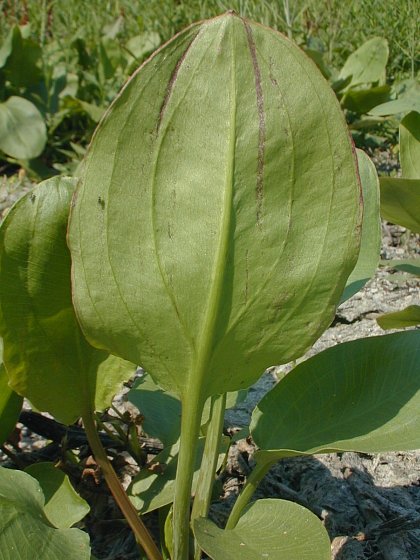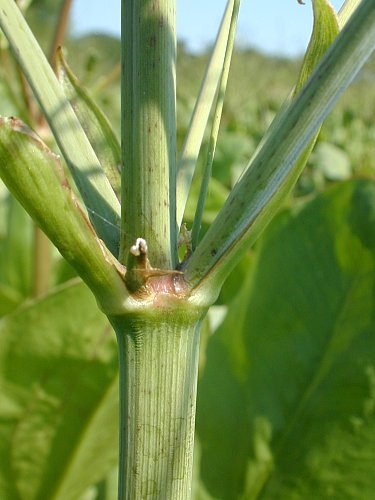Description: This perennial plant consists of a rosette of basal leaves about 1' tall. The basal leaves are up to 7" long and 4" across (excluding the long petioles), and they are oval to ovate in shape. Their margins are smooth, while both the upper and lower surfaces are devoid of hairs. The leaf venation is parallel primarily, although there are secondary veins that radiate laterally to provide a slightly wrinkly appearance to the upper surface. The texture of these leaves is rather thick and fleshy. From the center of the rosette, a large whorled panicle of flowers develops during the summer that is up to 3' tall. This inflorescence is heavily branched and more or less erect. The green flowering stalks are hairless, and sometimes angular or finely ribbed along their length. At the base of each group of whorled branchlets, there are 3 deciduous green bracts that are lanceolate with elongated pointed tips.

The small flowers are individually about ¼" across. Each flower consists of 3 white petals, 3 green sepals, and 6 stamens. There is a small patch of yellow at the base of each petal, while the center of the flower is green. For this species of water plantain, the petals are about 50% longer than the sepals. The blooming period usually occurs during mid-summer and lasts about a month. Each flower is replaced by a flat whorl of seeds (technically, they are achenes). Each flat-sided seed is longer than broad, with a tiny beak at the top. The seeds are probably distributed by the movement of water. The root system consists of a cluster of shallow fibrous roots and rhizomes. This plant often forms colonies.

Cultivation:
This
emergent-aquatic plant prefers shallow water or wet mucky soil. The
surrounding water should be slow-moving or stagnant. It can withstand
droughty conditions better than most emergent-aquatic plants, although
the foliage may become yellowish green in response. Full or partial sun
is required, otherwise this plant may not bloom.
Range & Habitat:
Large-Flowered Water Plantain is an uncommon plant that is found
primarily in northern Illinois and scattered counties in central
Illinois (see Distribution
Map). This native plant occurs primarily in seasonal wetlands
that are prone
to drying out during summer droughts, including shallow marshes, edges
of shallow ponds and lakes, sloughs and temporary pools in wet meadows
or prairies, and shallow slow-moving streams. Like Alisma
subcordatum (Small-Flowered Water Plantain), this species can
tolerate considerable disturbance.

Faunal
Associations:
The flowers are visited by flower flies, small bees (usually Halictid
bees), and small beetles (such as ladybird beetles) for their nectar or
pollen. Two aphids, Rhopalosiphum
nymphaeae (Waterlily Aphid) and Rhopalosiphum nigrum,
suck plant juices from Alisma
spp. during the summer. The latter aphid has been found
only in Canada so far. Deer occasionally chomp off the panicles of
flowers and the tops of the foliage. Apparently, waterfowl and other
kinds of birds rarely eat the seeds.
Photographic Location:
A seasonal wetland consisting of small pools of water at Judge Webber
Park in Urbana, Illinois. The photographs were taken during a major
drought when the pools of water had dried up – the plants produced
large healthy panicles of flowers, nonetheless.

Comments: The large inflorescence of Alisma triviale has a rather ungainly appearance because the flowers are so small. The more common Alisma subcordatum (Small-Flowered Water Plantain) has even smaller flowers (only about 1/8" across), with the petals about the same length as the sepals. Otherwise, these two species are similar in appearance. In the past, they have been considered different varieties of the same species, Alisma plantago-aquatica americanum and Alisma plantago-aquatica parviflorum. The scientific name Alisma plantago-aquatica is commonly used for the water plantain of Eurasia. The common name refers to the similarity of the leaves to those of the common yard weed, Plantago major (Common Plantain).